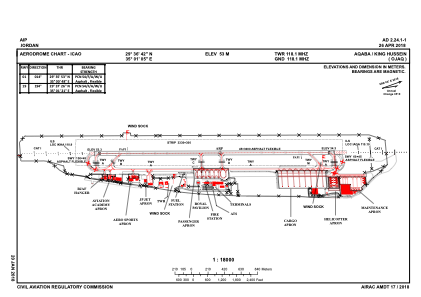Pilot Resources
Overview. Aqaba Airport ❲also known as King Hussein Int'l Airport (IATA: AQJ, ICAO: OJAQ❳ (Arabic: مطار الملك الحسين الدولي) is an airport located in the vicinity of Industrial City (Aqaba International Industrial Estate), northern suburb of Aqaba in Jordan.
Runway Use. 01 is used most of the time for departure and landing since it's the only runway equipped with an ILS (Instrument Landing System) however, 19 can be used if the wind favors it.
Transponder use on Ground. Mode S transponder is needed. Assigned code should be set upon start-up. Transponder have to be turned on when approaching the departure runway.
Scenery. Aqaba has some add-on sceneries that can be used by pilots. Default sceneries might have some wrong/missing taxiways and stands.
| FSX/P3D/MSFS Approved Scenery | XP11 Approved Scenery |
| MFSG | XP11 |
Charts. Charts can be accessed from several providers on the internet.
Uncontrolled Operations. When POSCON ATC is offline, the following frequencies should be used:
| Station | VHF Frequency |
| CTAF | 118.100 |
NOTE: No ATIS in OJAQ.
Terminal Layout.
Gate Assignment. Civil Aircraft shall park at the Civil Apron, Cargo Aircraft shall park at Cargo Apron (C stands).
Start-up Clearances. Aircraft should squawk their designated code and ask for start-up. ATC might give taxi instructions with the start-up clearance since all stands don't require push-back.
General Aviation. GA Aircraft and flights are the most type of flights done in OJAQ, GA usually park at the JP Jets Apron, RJAF, Aero Sports or Aviation Academy hangers. GA jets get start-up clearance and receive their flight clearance when approaching the departure runway.
Pushback and Startup. Stands at OJAQ do not require push-back since it's a straight taxi-out procedure. When ready, request start up from ATC, when completed, taxi can be requested.
Gate specific requirements. Stands at OJAQ require a special type of parking. When reaching the desired stand, you should do a 180 turn on the ramp and park facing the taxiway. That way a straight taxi-out can be achieved.
CPDLC Login. LOGON: OJAC
Taxi Procedures. Inbound and Outbound traffic shall taxi via A to the departure runway or assigned stand. For runway 01, departure from A or B, 19 departures shall taxi and depart only from A.
ATC Procedures. Aqaba has no radar services below FL150, procedural DEP/APP services to be provided by the radar controllers. Pilots should usually report, on initial contact with the radar controller, their passing altitude.
| AQT | Aqaba Tower | 118.100 |
| AQA | Aqaba Approach | 119.200 |
Initial climb for all SIDs from OJAQ is 8'000FT due to terrain.
De-icing Procedures. Nil
Noise Abatement Procedures. Nil
Arrival Routes. Traffic approaching to land at OJAQ shall expect the radar controller to assign a STAR or radar vectoring to the final approach path.
Speed Restrictions. Unless approved by ATC, all aircraft below 10,000FT shall not exceed 250 KTS IAS.
Missed Approaches. Due to extremely high terrain at Aqaba, pilots should inform ATC as soon as the missed approach is going to be performed. Most of the time the instruction would be up to 6,000FT or 8,000FT depending on the situation.
Clearing the runway. Pilots should vacate the runway when able at any of the rapid exit taxiways.
ATC Procedures. Aqaba's approach might be complicated, so you need to have the approach charts ready while performing the approach. Pilots shall expect procedural ATC services (position reports) below FL150.

